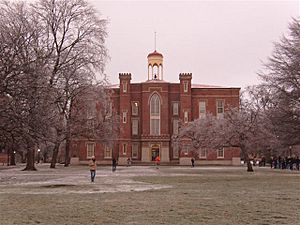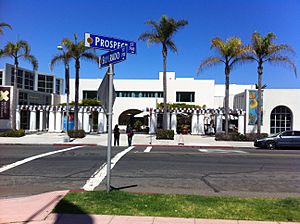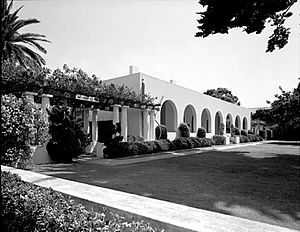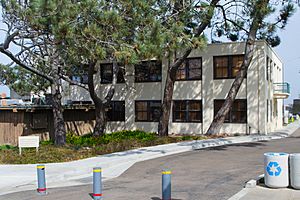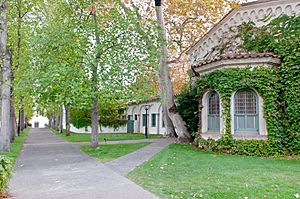Ellen Browning Scripps facts for kids
Quick facts for kids
Ellen Browning Scripps
|
|
|---|---|
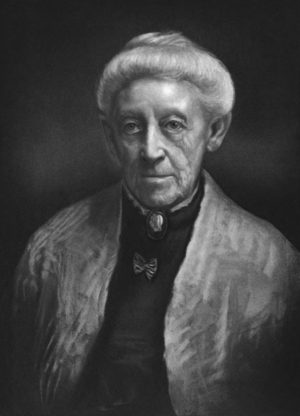 |
|
| Born | October 18, 1836 |
| Died | August 3, 1932 (aged 95) |
| Alma mater | Knox College |
| Known for | Philanthropy, Journalism |
| Parent(s) | James Mogg Scripps Ellen Mary Saunders |
| Relatives | James E. Scripps, (1835–1906; brother) E. W. Scripps, (1854–1926; half-brother) |
Ellen Browning Scripps (born October 18, 1836 – died August 3, 1932) was an American journalist and philanthropist. A philanthropist is someone who gives away a lot of money to help others. Ellen was a founding donor for many important places in Southern California.
She and her half-brother, E. W. Scripps, started the E. W. Scripps Company. This became America's biggest chain of newspapers. These newspapers connected cities in the Midwest with growing towns in the West. By the 1920s, Ellen Browning Scripps was very wealthy. She was worth about $30 million, which is like $388 million today. She gave most of this money away.
In 1924, she helped start the Scripps Research Institute (TSRI) in La Jolla, San Diego. She was even on the cover of Time magazine after founding Scripps College in Claremont, California. She also gave millions of dollars to groups around the world. These groups worked to support fair government and education for women.
Contents
Family Background
Ellen Browning Scripps was born in London, England, on October 18, 1836. Her father, James Mogg Scripps, was a bookbinder. He learned his trade from a famous bookbinder in London.
James Mogg Scripps had six children with his second wife, Ellen Mary Saunders. Ellen Browning Scripps was one of these children. Her older brother was James E. Scripps. Her younger half-brother was E. W. Scripps, who became a famous newspaper owner.
After his second wife died, James Mogg Scripps moved to the United States in 1844. He brought his six children with him. They settled in Rushville, Illinois. There, James Mogg married his third wife, Julia Osborn. They had five more children, including Edward Willis, also known as E. W. Scripps.
Life Story
Early Years
Ellen Browning Scripps grew up in Illinois. She was the only one of her ten brothers and sisters to go to college. She studied science and math at Knox College in Galesburg, Illinois. This college was one of the few places that allowed women to study.
She finished her studies in 1859. After that, she went back to Rushville, Illinois. She worked there as a teacher in a small, one-room school.
Newspaper Work
After the American Civil War, Ellen stopped teaching. She moved to Detroit, which was a busy city at the time. She joined her brother James E. Scripps to publish The Detroit Evening News. This newspaper was short, cheap, and didn't take sides in politics. It was made for the working people of the city. This newspaper was the start of the Scripps family's wealth.
Ellen wrote a daily column called "Miss Ellen's Miscellany." It shared local and national news in short, easy-to-read pieces. Her columns later inspired a news service called the Newspaper Enterprise Association. In the 1870s and 1880s, the Scripps newspapers grew. They included The Cleveland Press and The Cincinnati Post.
Ellen was a shareholder, meaning she owned part of the company. She gave business advice to her younger half-brother E.W. She also supported him in family money disagreements. E.W. said she saved him from financial trouble more than once.
World Travels
In 1881, Ellen and E.W. traveled to Europe. E.W. needed a break from work to get better. They traveled through France by train and then by ship to Algeria. After that, they went to Italy, Austria, and Germany. Ellen wrote weekly letters back to The Detroit Evening News. She described what she saw and felt about the places and people.
When Ellen returned to the News, her help was not needed as much. So, she spent the next ten years traveling. She visited the American South, New England, Cuba, and Mexico. In 1888–1889, she went to Europe again. This trip included a visit to a big exhibition in Paris and three months in Spain. Ten years later, she toured France, Belgium, and England.
Life in California
In 1887, Ellen's sister Julia Anne moved to Alameda, California. She hoped to find help for her severe rheumatoid arthritis. Ellen visited California for the first time in 1890 because she was worried about her sister. Soon after, Ellen and E.W. bought land in San Diego. They started Miramar Ranch with their brother Fred. This ranch is now part of Scripps Ranch and the Marine Corps Air Station Miramar.
Ellen lived at Miramar sometimes until 1897. Then, she moved into a house she built by the sea in La Jolla. She named it South Molton Villa, after the street where she was born.
Ellen started to meet many new friends, especially women. La Jolla had many women living there, including those who were not married or were widows. Ellen was a founding member of the La Jolla Woman's Club. She also got involved in many causes that aimed to make things better for society. In 1909, she and her sister Virginia helped start The Bishop's School. It was a special school for girls.
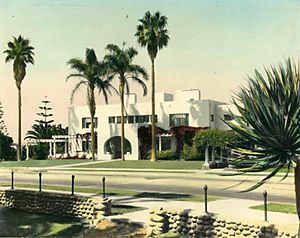
Her house, South Molton Villa, was next to Wisteria Cottage, owned by her sister Virginia. Wisteria Cottage was updated in 1910 by architect Irving J. Gill. He was a leader in modern architecture. Today, Wisteria Cottage is a gallery for the La Jolla Historical Society.
In 1915, South Molton Villa was destroyed by fire. Ellen asked Irving Gill to build a new house. This new house was made of concrete and was fireproof. It was built in the same modern style as The Bishop's School and the La Jolla Woman's Club. Many people say it is one of Gill's best works. In 1941, Ellen's helpers gave her house to The Art Center. This later became the Museum of Contemporary Art in La Jolla.
Her Wealth
Ellen Browning Scripps became very rich by investing in E.W. Scripps's growing newspaper business. E.W. formed a partnership with Milton A. McRae in 1894. George H. Scripps joined them in 1895. They managed many newspapers, including The Cincinnati Post and The Cleveland Press. They also bought newspapers in other cities like Memphis, Denver, and Houston.
In the late 1890s, E.W. started buying newspapers in California. These included The Los Angeles Record and The San Diego Sun. In the Pacific Northwest, they bought papers like The Seattle Star. These papers were popular with workers like dock workers and miners. By 1905, E.W. said his Western papers made much more money than his Eastern ones.
When George H. Scripps died in 1900, he left his shares of Evening News stock to E.W. Ellen received George's shares of the Scripps Publishing Co. This led to a long legal fight that Ellen and E.W. eventually won.
Giving Back
Ellen Browning Scripps was very interested in science and education. She gave most of her money to the Scripps Institution of Oceanography, The Bishop’s School in La Jolla, and Scripps College in Claremont, California.
She also paid for the building of the La Jolla Woman's Club, the La Jolla Recreational Center, and the Torrey Pines State Natural Reserve. She also supported the La Jolla Children's Pool. She was an important early supporter of the San Diego Zoo. After she broke her hip and stayed in the hospital, Ellen helped start the Scripps Memorial Hospital. She also funded the Scripps Research Clinic. These organizations later became The Scripps Research Institute and part of Scripps Health.
The New York Times newspaper said that during her life, she gave away more than $2 million. This was a huge amount of money at the time.
Her Passing
Ellen Browning Scripps died at her home in La Jolla on August 3, 1932. She was almost 96 years old. After she passed away, a leading newspaper magazine praised her. It said she helped American journalism more than any other woman. The New York Times called her a "pioneer in modern American journalism." Her obituary said she had mastered "the art of living" and the art of giving.
Her Legacy
In 2007, Scripps was honored and added to the Women's Hall of Fame. This was hosted by the Women's Museum of California and other groups.
From the 1920s, Scripps was the main supporter of the San Diego Natural History Museum. She paid for its building and education programs. In 1933, her estate gave over 1,000 watercolor paintings of California wildflowers by A. R. Valentien to the museum.
Here are some of the places Ellen Scripps helped to start or fund:
- Scripps College in Claremont, CA
- Scripps Institution of Oceanography, UC San Diego, started in 1903
- Scripps Research Institute
- Scripps Aquarium, La Jolla (now Birch Aquarium at Scripps)
- The Bishop's School in La Jolla, San Diego, CA
- Scripps Memorial Hospital
- Scripps Metabolic Clinic
- La Jolla Woman's Club
- Torrey Pines State Reserve
- The Children's Pool, started in 1931
- Donations to:
- Pomona College
- Knox College
- Cleveland College and Cleveland Museum of Natural History
- Constantinople Women's College
- San Diego State University ([Scripps Cottage])
- City of Rushville, Illinois
- San Diego Museum Association
- The Children's Home, San Diego
- St. James by-the-Sea Episcopal Church, La Jolla
- La Jolla Athenaeum Music & Arts Library
- La Jolla-Riford Branch Library
- San Diego Society of Natural History
- San Diego Museum of Man's Ancient Egypt exhibit
- San Diego Zoo
- San Diego YMCA and YWCA
- Asilomar Conference Center (YWCA)
- Community Welfare Building
- Travelers Aid Society of San Diego
Images for kids
-
Ellen Browning Scripps's house, South Molton Villa II, designed by architect Irving J. Gill.
See also
 In Spanish: Ellen Browning Scripps para niños
In Spanish: Ellen Browning Scripps para niños


